Greetings,all.
I just want to make a psot about a whole picture on my blog.
the whole picture in this blog isn't mine.But,belong to Juon Yu.The owner of DeadxEndxLess blog and Beyond The Limit blog.
I just take the picture from that site and other website.
So,once again,all picture on this blog ISN'T mine.
Thank you.
The Name Shall Not Be Shown
Welcome to my own Blog. This Blog is just about my poetry or song Lyrics or my video or anything else. Please Enjoy 2016 Update: This Blog is DEAD
Thursday, 26 May 2011
Wednesday, 6 April 2011
Mail Jeevas
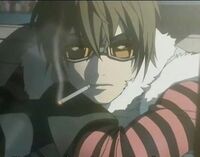 Matt, Mello's accomplice & friend | |
| Debut | Manga: Chapter 83 Anime: Episode 32 |
| Birthday | February 1, 1990 (1993 in the anime) |
| Deathdate | January 26, 2010 (2013 in the anime) |
| Also known as | Mail Jeevas |
| Sign | Aquarius |
| Age | 19 |
| Status at debut | Mello's accomplice |
| Relations | Mello (accomplice, friend) |
| Seiyū | Tomohiro Nishimura |
| Voice actor | Drew Nelson |
| Knowledge | 6/10 |
| Conceptualization Power | 6/10 |
| Will to act | 7/10 |
| Motivation | 7/10 |
| Social Skills | 3/10 |
Matt (マット, Matto), real name Mail Jeevas (pronouced Mile) (マイル・ジバス, Mairu Jibasu), was Mello's accomplice and friend from Wammy's House, and was considered the third most talented member of the orphanage. He first appears in Chapter 83 (Volume 10, page 70) of the manga, and in episode 35 of the anime.

History
Matt is first seen in the manga as Mello's accomplice in spying Misa Amane, and later, Mogi and Aizawa. After letting his guard down, he lost track of them and eventually follows Mello to Japan in their pursuit. He is only seen again during Takada's kidnapping, where he distracts her bodyguards with a smoke gun, allowing Mello to kidnap her. After some time, he gets cornered by the bodyguards and is shot multiple times after surrendering. In the anime he hid a gun inside the back of his shirt which he tried to take out. A total of twenty four bullets went into his body. The bodyguards later state that they never intended on bringing him in alive because of their belief and loyalty to Kira, claiming that Matt wouldn't reveal anything about the kidnapping and that death the only punishment for Matt's crimes. Mello later sees the news of his death broadcast on TV, and apologizes for having gotten Matt killed.Later in the manga, a tv broadcast reports that his indentity is unknown, and that the bodyguards were forced to shoot because he was showing a dangerous and aggressive behaviour, even though he surrendered peacefully.
Concept
According to How to Read, Matt enjoys video games and is not outgoing. He also seems to be a chain smoker, using his last breath to smoke his cigarette. He is also directly behind Near and Mello in succeeding L.Ohba said that he created Matt because when Mello started to act alone Ohba believed that he would find difficulty in advancing the story unless Mello had a character to interact with. Ohba said that to a reader Matt may appear to play video games and have no other actions, but he said that Matt's existence was "important" in the story. In response to a question inquiring which characters the creators had the most difficulty creating, Ohba cited Matt and said "I didn't even know what kind of person he was!"
Obata said that he did not receive advance notice towards Matt, who had the character concept of "a young man who loves gaming and doesn't really care much about the world." Obata said that he remembered seeing the thumbnails and asking his editor "Who's this character?!" The thumbnails gave Matt a bowl haircut and goggles; Obata instead drew "what he liked". Obata added that he could "create Matt naturally" as he had a "he probably won't do much" mentality regarding characters introduced in the Near and Mello arc.
Matt's appearance was a total of 18 panels in the manga (spread out over chapters 83-87 and 98-99) and two episodes in the anime, though only for a few minutes, in a non-speaking cameo in episode 32 and a speaking role in episode 35 (where the events of Takada's kidnapping and his death was depicted).

Trivia
- Matt is the only one of the best known Wammy Boys that Linda didn't draw.
- Matt is also one of the few characters in Death Note to admit out loud that Misa is "cute", but this only happens in the manga during the time he was instructed to keep an eye on her.
- In the anime and manga, Matt is left handed.
- He resembles the facial features of Matsuda.
- Matt, Weddy, Demegawa and Ukita are the only characters in the series shown to smoke. (Note: the scene in which Ukita smokes wasn't shown in the anime)
- Matt used his last breath to take a puff of his cigarette.
- In the anime, Matt's car is a red 1970 Chevrolet Chevelle SS 450; the epitome of the American sportscar.
- Despite being a minor character with few appearances, Matt is one of the most popular characters of the series.
- Matt was made so Mello wouldn't be lonely.
Nate River
 Near, next in line for the position of L. | |
| Debut | Manga: Chapter 59 Anime: Episode 26 |
| Birthday | August 24, 1991 (1994 in the anime) |
| Deathdate | N/A |
| Also known as | Near N (The Third) L |
| Sign | Virgo |
| Age | 13 pre-timeskip, 17-18 post-timeskip, (21 in post-series one-shot) |
| Status at debut | Resident at Wammy's Orphanage |
| Relations | Mello (adversary later accomplice) |
| Seiyū | Noriko Hidaka |
| Voice actor | Cathy Weseluck |
| Knowledge | 9/10 |
| Conceptualization Power | 10/10 |
| Will to act | 6/10 |
| Motivation | 10/10 |
| Social Skills | 1/10 |
Character
Nearly four years after the death of L, he works for the United States under the SPK team that is established to investigate Kira. He soon manages to deduce that Light Yagami, posing as L, actually is Kira. After finding that Mikami is Light's proxy and after Mello kidnaps Takada (which reveals Light's deception of having Mikami use a fake Death Note to lead Near on), Near is able to switch the real Death Note with his own fake version, allowing him to set up a final confrontation which leaves Light exposed.Near claims neither he nor Mello of could surpass L alone, but together they have done so inadvertently by working together. Near soon takes on L's name and keeps on the surviving members of the SPK as his subordinates.In the one-shot taking place after the series, Near is shown as the new L. A new Kira emerges who has gained a Death Note from the shinigami Meadra (Midori in Viz's translation of Death Note: How To Read 13), who had received the additional Death Note from the Shinigami King by giving him 13 apples she had taken from the human world. The new Kira murders elderly people in Japan to "relieve their pain." When Near's SPK subordinates ask him why he isn't taking any action, he replies that he is trying to think what would of the previous L would do. He finally reaches a conclusion that the prevailing Kira was just a killer without a purpose, and he labels the killer as "C-Kira" for "Cheap Kira." He announces on national television, under the alias of "L," that he is not interested in this case and that he also has deduced that this Kira is not the real Kira but only an "abominable murder." This results in C-Kira committing suicide. Throughout the 40-page manga chapter, the identity of the new Kira is not revealed.
Tsugumi Ohba, the writer of Death Note, said that Near becomes less likeable as the story progresses, citing the upcoming plan to have the notebook at a later point in history. Ohba said that a negative reaction led to a difference in their attitudes and that people may have seen Near as a cheat or wannabe L. Ohba added that Near's cheeky behavior, intended to reinforce his childishness, had been construed as annoying. Also, in Death Note: How To Read 13, it is included that generally speaking, his personality is dry, and he values results above all else.
In the final chapter, Near brings finger puppets to the Yellow Box Warehouse. Takeshi Obata, artist of Death Note, said that Near first brought the finger puppets and drew on them with a magic marker. Obata then said Near must have created the other puppets afterwards. Obata sees that Near doesn't really like L so much (although he respects him, he doesn't realy like him as a person), as Near says "If you can't win the game, If you can't solve the puzzle, then you're just a loser". Refering to L as a loser, so Obata had Near depict L as ugly; however, Near worked hard on the Mello's puppet as Near liked Mello.
Conception and development of Near

Ohba said that he gave Near a hobby of playing with toys (mostly robots); he also stacks "things" as a development from L's hobby of stacking sugar cubes emphasising his child-like appearence. Ohba included the match and the dice towers in his thumbnails and said that he thought Obata might encounter difficulty in drawing them. Ohba felt surprised when he saw the dice towers in the final work.
The given name "Nate" comes from the word "natural," and "River" symbolizes that Near's talents flow from L. Therefore, Near is the natural successor to L. The name is "supposed" to show that Near is a "natural genius blessed from above." The nickname Near is composed of the first and last letters of Nate River then swapped around to make a recognizable word.

Obata said that when he first saw Near, he "didn't even know what the heck he was wearing." He said that "it was tough" drawing Near's apparel as he did not understand the assembly of his clothes. Obata said that he settled for pajamas [because of the "toyish" theme Near represents] and "things got a lot easier."
Obata added that the designs for the characters became switched at the design phase; the final Mello had Near's design and vice-versa. Obata said that when he created a depiction of the designs, his editor wrote the wrong names accompanying the designs; then Obata received approval, and he could not say that the labels were incorrect. Obata said that, for him, Near was "more evil." He felt that "it's better" that the switch occurred.
Obata stated that as he drew Near, the concept of his immaturity became "stronger and stronger" as he believes that such traits are best revealed "gradually." Obata cited the fact that in the beginning Near's sole toy consisted of darts.
Ohbadh said that the finger puppets used by Near in the final chapter did not exist in the thumbnails and that he felt the final scenes "looked cooler" with the presence of the puppets. Obata said that he felt he could express "negative" parts of Near with the puppets. Ohba added that one could see "his dark side in his kind of puppets he used."
Personality

Even though his intelligence is that of a genius, he lacks social knowledge and is bad at interacting with others, so "he is only able to release his true powers when he has the support of his members."
Interests
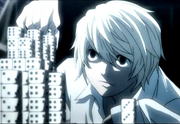
Normally, his fixation with toys is light, but he does seem to have things that he particularly likes since he has taken these with him when he had to escape. Three years after the main story, Near takes an interest in building Tarot card stacks. Of course, these structures are far beyond normal size, easily covering an entire room. It appears that Near would despise anyone who would knock down these structures, accidentally or intentionally. He also seems to have a love for dice. Near could also be described as "apathetic." He tends to feel that emotions will carry him away and will reduce his focus on more important ordeals.
Although Near is always surrounded with toys, none of them are electronics. All of his toys are the types that need to be moved manually such as the action figures, darts and dolls (except for the remote-control rubber ducks powered with batteries and a batterie-moved train). In Death Note 11 he uses toys to explain the case. Near is never shown playing a video game, or anything of electronic screen-game sorts such as Game Boy, PlayStation, or even Arcade games like Matt did. Whether he has no interests in video games, they're too much trouble to be carried during investigations, or he avoid the risk to harm his eyesight, it is unknown.
In Other Media
L: Change the WorLd
In L: Change the WorLd, L gives a talented Thai boy with a gift for calculations the name "Near." L hopes for the boy, the sole survivor of a Thai village ravaged with a deadly disease, to succeed him as L as he knows that the rules of the Death Note will kill the experienced detective within a short period of time. Near does not speak much in the movie (during the movie, he only says numbers and letters) and when he does, he speaks only in English. Like many of the characters during the transition from animation to live action, Near is portrayed with black hair instead of white hair as seen in the anime. Near is portrayed by Narushi Fukuda in the film and voice by Michael Strusievici in the English Dub. For reasons unknown, even though L was shown giving him the name of "Near," he was listed as "BOY/ニア" in the credits.Novel
In L: Change the WorLd (novel) based on the film, Near is described as being the original Near as he appeared in the original Death Note series. However, due to the plot in which Kira killing L is absent, the requirement of an immediate nominee as successor is not necessary. As a result, the eight-year old Near is claimed to be working on a different case involving the prevention of World War III since the timeskip present in the original series is absent. The plot in which Near was a Thai boy is also completely absent from the novel due to plot changes made as a result of severe dissatisfaction with Near's depiction in the film by fans.It is quite unclear how Near was able to create a puppet of L. Since L hid in the shadows and lived a secret life, his face was almost never exposed to the outside world without his consent. Some fans speculate that Near has obtained at least one photograph of L given to him from either Roger or Watari during his time at Wammy's House.
Trivia
- It is revealed 3 years later (after Light Yagami's death) that Near not only takes on the name of L but also grows up to look more like the original L himself. Near begins to have the sharp bags under his eyes and also almost reaches the same height as L.
- Like Mello, his name comes from the opposite of his personality; Near, therefore, is very distant from other people.
- Throughout the whole of the manga series, Near is almost always seen hunched over. He is only seen standing five times: in front of the president of the United States in chapter 60, when the vice-president recognizes Kira in chapter 75, while he talks with Lester in chapter 76, when he picks up his toys in chapter 80 and when he discovers Mikami as Light's proxy in chapter 91.
- In the anime, he is seen standing in a scene where Light and Near are opposite each other on a moving platform, and Near is shown standing up when he guesses that Teru Mikami is X-Kira. Both scenes are in episode 33 of the anime.
- In the one-shot of the manga Near is shown eating chocolate, possibly in homage to Mello as it is the same brand. It could also be symbolic for the fact that he and Mello came together and did what L couldn't do.
- Near appears to be ambidextrous, playing darts with his left hand and stacking dice with his right.
- Near appears to have albinism, with his white hair and pale grey eyes.
- It is revealed in the novel "L Change the worLd" that Near was the chosen successer to L if L had to make his choice. However, there was no mention or discussion about Mello in the book.
- When Teru Mikami used his Shinigami eyes, the numbers of Near's Lifespan are: 43406
- In Death Note: How To Read 13, it says that Near is distant from people because he is sensitive. This questions his true personality.
Mihael Keehl
| Debut | Manga: Chapter 59 Anime: Episode 27 |
| Birthday | December 13, 1989 (1992 in the anime) |
| Deathdate | January 26, 2010 (2013 in the anime) |
| Also known as | Mello M |
| Sign | Sagittarius |
| Age | 14 pre-timeskip, 19-20 post-timeskip, (20 at death) |
| Status at debut | Resident at Wammy's, Near's rival/adversary |
| Relations | Matt (accomplice) Near (rival; ally) |
| Seiyū | Nozomu Sasaki |
| Voice actor | David Hurwitz |
| Intelligence | 7/10 |
| Creativity | 7/10 |
| Initiative | 10/10 |
| Emotional Strength | 8/10 |
| Social Skills | 9/10 |
after, stating "I'll find my own way," and eventually seeks help from the Mafia. Mello has sometimes been known to use less conventional methods to achieve his goals, including kidnapping the Director of the Japanese Police's daughter. He also relied on information leaked from an informant, (Ill Ratt) from the SPK in order to write most of the SPK member's names in Sidoh's Death Note. Later, he also relies on Halle Lidner for intelligence about the connection between Kiyomi Takada and Light Yagami.
Similar to L's fondness for sweets, Mello is often seen eating bars of chocolate. Another thing about him that is very like L is his tendency to take drastic strategies to confuse and force the hand of his opponents. How to Read 13 states that Mello has an excellent mind and that he sometimes lets his emotions get in his way. The book cites his hatred of Near, which created a flaw in his personality. His birthday is December 13, 1989 (1992 in the anime) and he dies on January 27, 2010 (2013 in the anime). He is 171 centimeters tall (5' 6"), weighs 52 kilograms (114 pounds) and his blood type is A. He can usually be seen wearing leather clothes and a crucifix which was altered to a red stick-shaped charm for the anime adaptation.
Character
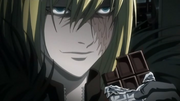
While Mello is certainly a genius and more intelligent than most people, the concept of being only the secondmost intelligent person in
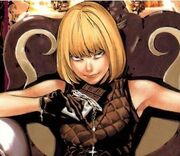
Mello is voiced by Nozomu Sasaki in the Japanese anime, and David Hurwitz in the English version.
The Race to Capture Kira

However, Light Yagami discovered the location of Mello's Mafia hideout by having Misa use her Shinigami eyes to discover the identity of one of Mello's Mafia accomplices, and then using the remaining Death Note to make him mail Light their location. The indirect result of this is that the Shinigami Sidoh, who was the original owner of the Death Note Mello now possessed, also found out Mello's location and was able to get there first. Sidoh briefly struck up a loose alliance of sorts with Mello, revealing to him (in exchange for some of Mello's chocolate) that the two extra rules that Light made Ryuk write in the Death Note to fool L -- particularly the one saying that "if the user does not kill once every 13 days, they will die" -- were fakes. Mello begins to theorize that whoever Kira was, he probably used that rule to fool the Japanese police into thinking he was innocent. However, Light then launches a SWAT team raid on the hideout, leaving Mello in a face to face confrontation with Light's father, in which Mello revealed that he had the entire building rigged with remote-controlled explosives, leading to a tense showdown. In order to escape, Mello was forced to detonate all of the bombs, after one of his Mafia accomplices fatally wounded Light's father. Mello managed to survive the explosion and evade the police, but Mello was left badly scarred along the entire left side of his face above his mouth (the gas mask he was wearing at the time protected the rest). Worse, while Mello was still alive, the failure of his Mafia scheme left his real name in Light's hands.
Mello forces an entry into the SPK at gunpoint, to retrieve the one existing photograph of himself from Near. Each wryly promises the other that the race is on to see who finds Kira first. Mello leaves Near, but not before passing on the information to him from Sidoh about the two fake Death Note rules, which drastically sharpens Near's suspicions on Light Yagami. Mello then enlists the help of his friend Matt (the third best student at Wammy's House, behind Near and Mello) to spy on Misa.

Near reflects this during the final showdown and credits Mello as the single most pivotal person in discovering Light's plans. Halle Lidner further believes that it was Mello's plan that he would be killed, because he knew that the only way to reveal the true location of Mikami's Death Note was to force him to immediately need to kill someone, but Near disagrees.
Conception and development of Mello
Ohba said that he introduced Near and Mello together because L individually could not defeat Kira. Ohba felt that introducing one character individually would produce a "repeat" of the struggle between Light and L, so he instead wanted a story involving three combatants fighting each other. Ohba said that he let Takeshi Obata, artist of the series, create the character designs and asked him to make both characters look "a little 'L-ish.'" Ohba said that he "wavered" in their ages and considered making the characters the younger version of L. Ohba added that he did not initially develop their personalities as he wanted to "reveal" them through their actions.Ohba said that he added the chocolate trait because he believed that chocolate "represented all sweets" and that the trait would fit with the story arc in the United States. Ohba described the trait became "useful" during the discovery of Mello's base due to the discarded chocolate boxes. Ohba said that he added Mello's scar to the thumbnails as the trait would give him "more depth." These traits give Mello a unique character build.
Ohba recalled that he considered having Mello be the character who ultimately defeats Light. According to Ohba, after the disappearance of Sidoh, the writer "struggled" with Mello's role. Ohba's idea of Mello ultimately defeating Light and Near being "the best" was strong in his mind, but once Mello had "learned too much about the Death Note" he had to kill him to "sustain the intensity of the story." As a result, Ohba did not give Mello a "large role" at the conclusion of Death Note and instead had Mello negatively affect Light "indirectly." Ohba gave Mello a "very plain" death, depicted in only one panel; he felt that if Mello had perished "dramatically" it would reveal the truth behind his death.
Obata said that, since Ohba wanted to "include a little L" in Near and Mello, he tried to keep "the weirdness and the panda eyes." He also added that since L was an important character, he felt that he made Near and Mello look too much like L. He described the character designs as "a major struggle." Obata said that, when he first heard about Near and Mello, he assumed that Near and Mello would join as a team and work together, so he envisioned the two as twins when he created the character designs. Obata said that at first he tried to depict Mello as having "more energy than Near." At first, Mello's hair was cut straight across; Obata said that he preferred Mello's hair becoming messy, which occurred later in the story. Obata said that he felt grateful when Ohba added the scar since he felt that he could draw Mello "looking cooler." In addition 13: How to Read described Mello as looking "more intense" and "more human" with the scar. Obata said that he felt sad when Mello died in the story shortly afterwards. Obata added that he designed Mello's clothing based on "what I like," meaning clothes he enjoys drawing and not clothes that he enjoys wearing; Obata says that he enjoys drawing "shiny" leather. At the point he created the pages featuring the reappearance of Mello with his scar, Obata said that he "finally [felt that he could draw Mello] really well." Obata added that the fact that Ohba and Obata did not regularly meet in person was best, because if Obata told Ohba about his satisfaction with Mello's new appearance that Ohba may not have killed Mello.
Obata added that the designs for the characters became switched at the design phase; the final Mello had Near's design and vice-versa. Obata said that when he created a depiction of the designs, his editor wrote the wrong names accompanying the designs; when Obata received approval he could not say that the labels were incorrect. Obata said that, for him, Mello was "more calm and feminine." He felt that it's better that the switch happened.

In Other Media
Novel
Mello is the narrator of the Death Note spinoff novel, Death Note: Another Note - The Los Angeles BB Murder Cases. In it, he states that he is only telling the story in order to flaunt his greater knowledge of L over Near. He even describes Near as a "big-headed twit" in the book, but decides that Near might not be the only person to read it and decides to make it more interesting. While narrating, Mello uses different techniques: he begins as a typical narrator, but drops it to acquire a way of speech that is usually associated with a live storytelling. In the book he says that he does it because he would have gotten bored with writing it. The novel also switches from Mello's view and opinions to Naomi's point of view.Mello in L: Change the WorLd novel
Mello does not play a major role in L: Change the WorLd (novel) other than being the author of the novel.Trivia
- Although Mello gets his information of Matt's death from a small TV in his truck, it's not seen throughout his whole time in the truck other than at the point he has it on.
- Some people think that Mello's hair color changes throughout the anime, and it does, due to the coloring of his surroundings. In the Mafia room, his hair is orange because the lights are dim. In the SPK, his hair is a light blonde because the lights are bluish and faint, mostly from all the computer screens going at once which provides most of the light for the SPK room.
- According to the information, Mello has the highest social skill rating (9/10) of all Wammy boys, including Watari, Roger, Near, Matt, and L.
- Mello is the only character in the series to actually "publish" a real book that could be purchased in stores during the time that the events of the series were unfolding.
- As well as "publishing" a real book (this book being the novelization of "L: Change the World", on which he is known as 'M'), he provides the narrative voice in the other light novel "Death Note: Another Note (The Los Angeles BB Murder Case)", referring to himself as "The best dresser that died like a dog".
- It is remarked that, during one meeting with L, he was told three stories: One was of the LABB murder case, with later became the subject of a book, and the second being of the final fight between L and the real Eraldo Coil and Deneuve, the apparent result being that he took their detective codes for himself, and turned them into the second and third greatest detectives respectively. The third story is how L met Watari when he was 8.Due to DN: AN's success, more light novels have been hinted at, which will contain the other two stories recounted to Mello. Whether or not this will be followed through is undecided, but the chances that Mello will write them is highly likely.
Long Term Memory and Short Term Memory
Learning and Memory
In cognitive psychology, there is one memory system, but it is normally divided into three functions for storage (Anderson, 2000): sensory, short-term (often called working), and long-term (often called permanent).- Sensory Memory: The sensory memory retains an exact copy of what is seen or heard (visual and auditory). It only lasts for a few seconds, while some theorize it last only 300 milliseconds. It has unlimited capacity.
- Short-Term Memory (STM) - Selective attention determines what information moves from sensory memory to short-term memory. STM is most often stored as sounds, especially in recalling words, but may be stored as images. It works basically the same as a computer's RAM (Random Access Memory) in that it provides a working space for short computations and then transfers it to other parts of the memory system or discards it. It is thought to be about seven bits in length, that is, we normally remember seven items. STM is vulnerable to interruption or interference.
- Long-Term Memory - This is relatively permanent storage. Information is stored on the basis of meaning and importance.
| Donald Hebb (1968) argued that it was doubtful that a chemical process could occur fast enough to accommodate immediate memory, yet remain stable enough to accommodate permanent memory. Hence, the present theory of three storage areas. |
Miller's Magic Number
George Miller's classic 1956 study found that the amount of information that can be remembered in one exposure is between five and nine items, depending on the information.Applying a range of +2 or -2, the number 7 became known as Miller's Magic Number, the number of items which can be held in Short-Term Memory at any one time.
Miller himself stated that his magic number was for items with one aspect as his work is based on subjects listening to a number of auditory tones that varied only in pitch. Each tone was presented separately, and the subject was asked to identify each tone relative to the others he or she had already heard, by assigning it a number. After about five or six tones, subjects began to get confused, and their capacity for making further tone judgments broke down.
He found this to be true of a number of other tasks. But if more aspects are included, then we can remember more, depending upon our familiarity and the complexity of the subject (in Miller's research, there was only one aspect — the tone). For example, we can remember way more human faces as there are a number of aspects, such as hair color, hair style, shape of face, facial hair, etc.
We remember phone numbers by their aspects of 2 or more groupings. We don't really remember seven numbers. We remember the first group of three and then the other grouping of four numbers. If it is long distance, then we add an area code. So we actually remember 10 numbers by breaking it into groups of three. Social Security numbers work on the same principle — xxx-xx-xxxx (3 groups of numbers).
Information Processing Model
The progress of information through these storage systems is often referred to as the Information Processing Model (Marzano, 1998), which can be mapped as: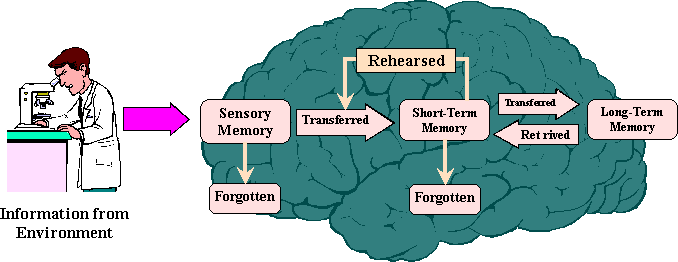
Short-Term Memory(STM)
STM is characterized by:- A limited capacity of up to seven pieces of independent information.
- The brief duration of these items last from 3 to 20 seconds.
- Decay appears to be the primary mechanism of memory loss.
- Iconic memory - The ability to hold visual images.
- Acoustic memory - The ability to hold sounds. Acoustic memory can be held longer than iconic memory.
- Working memory - An active process to keep it until it is put to use (think of a phone number you'll repeat to yourself until you can dial it on the phone). Note that the goal is not really to move the information from STM to LTM, but merely put the information to immediate use.
Also, on a more concrete level, the use of chunking has been proven to be a significant aid for enhancing the STM transfer to LTM. Remember, STM's capacity is limited to about seven items, regardless of the complexity of those items. Chunking allows the brain to automatically group certain items together, hence the ability to remember and learn better.
Our prior knowledge of pictures and faces allow us to see a “face” in the word “Liar”:
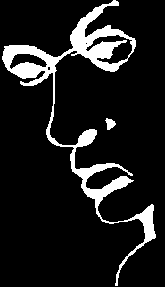
Long-Term Memory (LTM)
The knowledge we store in LTM affects our perceptions of the world, and influences what information in the environment we attend to. LTM provides the framework to which we attach new knowledge. It contrasts with short-term and perceptual memory in that information can be stored for extended periods of time and the limits of its capacity are not known.Schemas are mental models of the world. Information in LTM is stored in interrelated networks of these schemas. These, in turn, form intricate knowledge structures. Related schemas are linked together, and information that activates one schema also activates others that are closely linked. This is how we recall relevant knowledge when similar information is presented. These schemas guide us by diverting our attention to relevant information and allow us to disregard what is not important.
Since LTM storage is organized into schemas, instructional designers should activate existing schemas before presenting new information. This can be done in a variety of ways, including graphic organizers, curiosity-arousing questions, movies, etc.
LTM also has a strong influence on perception through top-down processing - our prior knowledge affects how we perceive sensory information. Our expectations regarding a particular sensory experience influence how we interpret it. This is how we develop bias. Also, most optical illusions take advantage of this fact.
An important factor for retention of learned information in LTM is rehearsal that provides transfer of learning.
References
Anderson, J. R. (2000). Learning and memory: An integrated approach. New York: JohnWiley & Sons.
Hebb, D. O. (1968). Concerning imagery. Psychological Review. 75, 466-477.
Marzano, Robert J. (1998). A Theory-Based Meta-Analysis of Research on Instruction. Mid-continent Aurora, Colorado: Regional Educational Laboratory. Retrieved May 2, 2000 from http://www.mcrel.org/products/learning/meta.pdf
Author Note:I take this article from http://www.nwlink.com/~donclark/hrd/learning/memory.html
Tuesday, 5 April 2011
Light Yagami
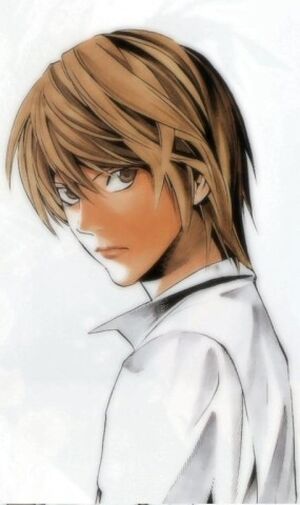 Light Yagami, the protagonist of Death Note. | |
| Debut | Manga: Chapter One: Boredom, Anime: Episode One: Rebirth . |
| Birthday | February 28, 1986 (1989 in the anime) |
| Deathdate | January 28, 2010 (2013 in the anime) |
| Also known as | (The First) Kira, (The Second) L |
| Sign | Pisces |
| Age | 17-18 pre-timeskip, 23 post-timeskip |
| Status at debut | Senior in high school |
| Relations | Ryuk, Soichiro Yagami (Father), Sachiko Yagami (Mother), Misa Amane (accomplice), Sayu Yagami (younger sister) |
| Seiyū | Mamoru Miyano |
| Voice actor | Brad Swaile |
| Knowledge | 9/10 |
| Conceptualization Power | 10/10 |
| Will to act | 8/10 |
| Motivation | 10/10 |
| Social Skills | 10/10 |
Light Yagami (夜神 月, Yagami Raito) is the protagonist and anti-hero of Death Note. At the start of the series, he discovers the Death Note and uses it to kill criminals, then becoming known to the people of Japan as Kira (based on the Japanese pronunciation of the English word "killer"). Light is characterized as an extremely intelligent yet bored young man, confident in his own sense of logic and how clever he is in regards to others. He is frustrated by the lack of justice in the world. Believing the world to be "rotten," he desires a means by which he can enact his will to purge the world of all evil. Light is unaware that he is not alone: a Shinigami (God of Death) named Ryuk is tired of the rotten Shinigami Realm. This Rogue Shinigami drastically changes Light's life and world forever.
In the year 2003 (2006 in the anime), Light Yagami discovers a mysterious notebook on the ground at his school. Written on the cover: the words "Death Note". The Death Note's instructions state that if a human's name is written within it, that person shall die. Light is initially skeptical of the notebook's authenticity, but after experimenting with it, Light realizes that the Death Note is real. It is in this way that Light Yagami found his true purpose in life: to become Justice by judging and killing all criminals with the Death Note. Light feels that he is the only one fit to judge humanity, thus he decides to create a New World where he alone is "God." After meeting the previous owner of the Death Note, a Shinigami named Ryuk, Light seeks to control the world with Divine Rule, passing judgment on those he deems to be evil or those who get in the way of his goals.
A short time later, Light sets to work ridding the world of criminals, attracting the attention of the master detective L. Light and L encounter each other in several different battles of wit and logic throughout the first arc of the series. Once the second Kira, Misa Amane emerges, L is able to corner them both. After giving up the Death Note briefly to clear their names, Light is able to manipulate Rem into saving Misa's life. Kira's goal: to kill L, antagonist and arch-rival to Kira. When L is attempting to test the Death Note, Rem realizes that Light has trapped her. She is forced into a situation where she must choose: the life of Misa Amane, or her own existence as a Shinigami. It is only then that Rem has an epiphany: Light Yagami has surpassed all Shinigami, having the ability to even kill "immortal" Shinigami. Rem kills both L and Watari, and then dies, leaving her Death Note at Light's disposal.
With L dead, Light takes up his mantle in order to hide L's death from the world, becoming the second L while also putting him in the perfect position to continue killing criminals as Kira. He comes into contact with L's true successors, Near and Mello, who are out for revenge in the name of the true L: Mello wants Light dead, Near wants him exposed as Kira. After making a mistake in using Teru Mikami as a proxy, Near is finally able to corner Light. Having decided that it is time to end Kira's game, Ryuk decides to kill Light.
Light constantly tries to evade the suspicion of L while both maintaining his identity as "Kira"—the name derived from the Japanese pronunciation of the English word "killer" (キラー, Kirā?)—and cleansing the world of crime. The fact that he is a genius also adds to his notion that only he is fit to judge humanity and steer it on a proper moral course.
Light Yagami, born on February 28, 1986 (1989 in the anime), is a third year high school student (12th Grade) at Daikoku Private Academy while also attending supplemental classes at Gamou Prep Academy in the beginning of the story. Light has a father, Soichiro Yagami, who is a member of the investigation team opposing Kira. In addition, Light has a mother, Sachiko Yagami, and a younger sister, Sayu Yagami.
History

When L is finally able to corner him, Light puts his master plan in practice. He temporarily gives up his Death Note to Ryuk, erasing his memories about his time as Kira from his mind. Rem, under instruction by Light to give it to someone who would use it selfishly, gives it to Kyosuke Higuchi of the Yotsuba Corporation. Now unaware of the fact that he was the original Kira, Light accepts L's offer to join the investigation team to hunt down Higuchi, known as the third Kira. Light requests the alias "Light Asahi" to be used for him. When Higuchi is finally captured, Light touches his Death Note, thereby regaining his memory of when he was the original Kira. He then proceeds, exactly as planned, masterfully killing Higuchi by using the Death Note paper he put in his watch before he lost his memories; and manipulating Rem, who also dies in the process, to kill both Watari and L.
Light is later nominated by L's investigation team (who are unaware that he is Kira) to act as L, due to the fact that they cannot reveal the death of the real L to the world. Light also takes over the role of L's assistant, Watari. Now able to act as both Kira and L, Light can continue killing criminals while leading the investigation team in circles. His secret identity as L is soon discovered by the Special Provisions for Kira, President David Hoope, and Mello's gang. Light joins the Japanese Police Force's Intelligence Department in April 2009, believing that no one can stop his plans. Near and Mello eventually appear before him, trying to accomplish what L could not: to expose Kira's true identity, and bring him to justice. At this point, according to How to Read 13, Light becomes "overtaken with evil" and possessing "arrogance that came with Kira's power"; Light loses sight of his former self.
In the end, the combined efforts of Mello and Near, combined with a large miscalculation and miscommunication on the part of Mikami and Light, force Light to reveal himself as Kira. In the final clash between Near and Light at a warehouse, all is revealed and the Kira case comes to an end after six long years.
According to the manga, Light's date of death is January 28, 2010. His height and weight are 179 centimeters (the height is 5 feet and 10 inches in the VIZ How to Read) and 54 kilograms (119 pounds), respectively. His blood type is A (see Japanese blood type theory of personality).
Light constantly tries to evade the suspicion of L while both maintaining his identity as "Kira"—the name derived from the Japanese pronunciation of the English word "killer"—and cleansing the world of crime. The fact that he is a genius also adds to his notion that only he is fit to judge humanity and steer it on a proper moral course.
Fate

In the anime version, Light manages to flee the warehouse after Teru Mikami commits suicide. Near instructs the team that there is no reason to pursue Light given that there should be no more hidden Death Notes, and Light's wounds would prevent him from getting far. Despite this, Shuichi Aizawa, Kanzo Mogi, Hideki Ide and Touta Matsuda tried to follow Light but are unable to find him before he dies on the staircase of a nearby warehouse due to cardiac arrest: Ryuk wrote his name in the Death Note. As Light slowly closes his eyes, an image of L appears before Light, mirroring Light standing over L in episode 25 at L's death. At the end of the second one-shot special, a deleted scene is shown, in which Aizawa and Matsuda enter the warehouse Light had fled to; their expressions of shock imply that they have seen Light's body.
In the one-shot special of the anime, an Unnamed Shinigami appears in the Shinigami Realm. This new Shinigami asks the others where the Rogue Shinigami named Ryuk is. Members of the fanbase believe this Unnamed Shinigami to be the reincarnation of Light Yagami due to five pieces of evidence: his coat looks similar to Light's when he died, he walks up stairs to meet Ryuk (a subtle reference to Light's death); the way he tosses the apple to Ryuk; the fact he inexplicably knows Ryuk's love for Apples (without asking the other Shinigami) and the fact that Ryuk says "Raito" (Light's real name) after the Unnamed Shinigami leaves. This could denote that either he realized the Shinigami's identity at the end or is merely acknowledging Light as if he were there in spirit or otherwise.
Conception and Development
In Death Note: How to Read 13, Ohba said that Light was "a young man who could understand the pain of others" when he first encountered the Death Note. Ohba said that if Ryuk never developed an interest in the human world, Light would have become "one of the greatest police leaders in the world" who, with L, worked against criminals. Ohba added that he believed that debating whether Light's actions were good or evil is not "very important." Ohba says that he personally sees Light as a "diabolical" character. Obata said that Light was his second favorite human character and that he was not sure whether that was because he "liked" Light or because he drew "such a diabolical character" in a magazine for children.Tsugumi Ohba, the story writer of Death Note, said that his editor suggested the family name "Yagami" for Light. Ohba said that he did not feel "too concerned" about the meaning of the name (the kanji are "night" and "god"); he said that after he created the final scene in the manga he "liked" that the final scene created "deeper significance" in the name.
Ohba described Light's life as "ruined" once he obtained the Death Note, and that Light became a victim of the Death Note "in many ways," Ohba described Light as bearing good faith intentions and having a "very conceited" nature. Ohba also describes Light as having a "warped" "desire to be godlike," bearing love for his family, and intending to transform the world into "a better place" Death Note: How to Read 13 also states that Light, "uncompromising" when achieving his ideals, "sullied" himself by using the Death Note and that his actions "may have been the result of the purity within him" prior to obtaining the Death Note.
Takeshi Obata, the artist of Death Note, said that he had "no trouble" designing Light as the character description presented to him, "A brilliant honors student who's a little out there," was "clear and detailed." As the weekly serialization continued, Obata simplified the design by unconsciously removing "unnecessary" lines and felt that he became "better" at drawing Light. When Chapter 35 appeared and the editor informed Obata that Light lost his memories, Obata felt that he had to "forget everything he learned" and draw Light in a similar manner as he appeared in Chapter 1. Obata said that he used "a lot of effort" to design Light's wardrobe. According to Obata, he encountered difficulty imagining the clothing of "a brilliant person," so he looked through fashion magazines. Obata envisioned Light as a "smart and formal guy" who wears formal shirts. Most of Light's clothing in Death Note is "fitted" and Obata avoided jeans.
According to Ohba, Light sees Misa Amane, who he uses as an accomplice, as a "bad person" who killed people, so he acts emotionally cold towards her and manipulates her. Despite this, he keeps her alive even after her memories of being Kira have been removed for the second (and final) time.
When designing color book covers Obata assigned colors to characters to "get the atmosphere right." Obata assigned clear or "lack of a color" to Light.
When asked about which character was most similar to himself, Ohba indicated Near and "maybe Light." Regarding Light Ohba cited "because I did well in school."
Film Summary
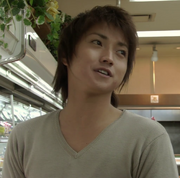
After Rem "kills" L and Watari, Light writes his father's name in an attempt to kill him, an attempt that ultimately fails. The endings of both the second movie and the manga are similar. In the second film, after being exposed as Kira, Light asks Ryuk to write the names of the team members in the book during the climax. The police shoot but do not kill Ryuk as he writes in the Death Note. Light laughs until Ryuk shows Light the Death Note, revealing that Light's name was written in the book. Light tries to stop Ryuk, passing through the Shinigami. Light dies in his father's arms, begging him to believe that he acted as Kira to put justice into practice. Justice, which Soichiro Yagami had taught Light since his childhood. The film concludes one year later, on Light's birthday. Sayu fetches Soichiro and says that Kira helped reduce crime rates. However, she says that she does not support Kira as Light was killed by Kira (which is what Soichiro told her). Light is portrayed by Tatsuya Fujiwara, known for his role as Shuya Nanahara of Battle Royale.
Conception and Development in the Film
Shusuke Kaneko, director of the film, intended for Light to appear sympathetic at the beginning of the film; when Light first gains the Death Note Kaneko "was careful" to have Light react in a manner "as you and I would." Kaneko changed the story involving Light gaining his first notebook as he felt that the audience "would have a hard time sympathizing" with Light if the scene remained the same as it was in the manga. Kaneko added that as he portrayed Light as "being enthralled" as he "becomes more cruel" to make the audience members feel that they could "do the terrible things he does" even if the members do not sympathize with Light.Tatsuya Fujiwara said that he felt difficulty portraying Light in the film series because of the lack of "action" and because Light has no signature mannerisms and therefore has his feelings displayed by his face; Fujiwara added that he struggled conveying Light's "incredible amount of intelligence" and that the performance would appear "very empty or simplistic" if Light received an improper portrayal. Fujiwara explained that he wanted Light to cry in a particular scene even though Kaneko told Fujiwara "Light doesn’t cry" since Fujiwara believed that the scene would feel "more honest"; Kaneko used the take.
Kaneko designed Light's room to reflect the character's personality by making it clean and neat and filling it with legal, criminal history, foreign, and academic books. The original version of Light's room included a stereo; Kaneko replaced it with a vacuum cleaner to reflect Light's "clean-freak self."
Kenichi Matsuyama, the actor who portrayed L, said that he and Fujiwara became "so immersed" in their character portrayals that they did not talk to one another while on the set; when filming ceased they conversed and "went out for a drink or two."
Reception
Tom S. Pepirium of IGN said that he felt surprise when he learned that some viewers, while watching the series, wanted Light to emerge as the victor of the storyline; Pepirium added that his wife said that she was "kinda rooting for Light." Pepirium compared wanting Light to win to "cheering for Kevin Spacey at the end of Seven." Pepirium added that Brad Swaile, Light's English-language voice actor, "nails" the "difficult" task of making Light "both likable and hated." Jason Charpentier of The Anchor stated that Light's attributes and his role as a main character form "part of what makes Death Note interesting."Tetsuro Araki, the director of the anime, said that he felt an urge to support and cheer for Light. Araki added that Light would have used and killed him if he was one of Light's friends, but the director still believed that Light is "that interesting" and therefore he would have felt an attraction towards Light.
Reception to film version character
Pauline Wong of OtakuZone had her opinions of the film portrayal of Light Yagami published in The Star, a Malaysian newspaper. In it, Wong says that the "very bishie-status-worthy" Fujiwara portrayed Light with "aplomb and near-perfection, right down to the evil little smile." Kitty Sensei, quoted in the same Malaysian article, says that the portrayal of Light in the film is "very faithful to the manga’s."Tatsuya Fujiwara, the actor who portrayed Light in the films, said that he "could understand" Light's intentions to create a new world even though "Murder is a horrible thing." Matsuyama describes L and Light as having "such unique characters that they’re impossible to understand." Erika Toda, the actress who portrayed Misa Amane in the films, described Light's and Misa's actions as "criminal."
Themes
1st theme-------------------------------------------------------------------------------------------------------------------------------------------------------------------------------------------------------------------------------2nd themeAuthor Note:I take this article from Death Note Wiki http://deathnote.wikia.com/wiki/Light_Yagami
Subscribe to:
Posts (Atom)
